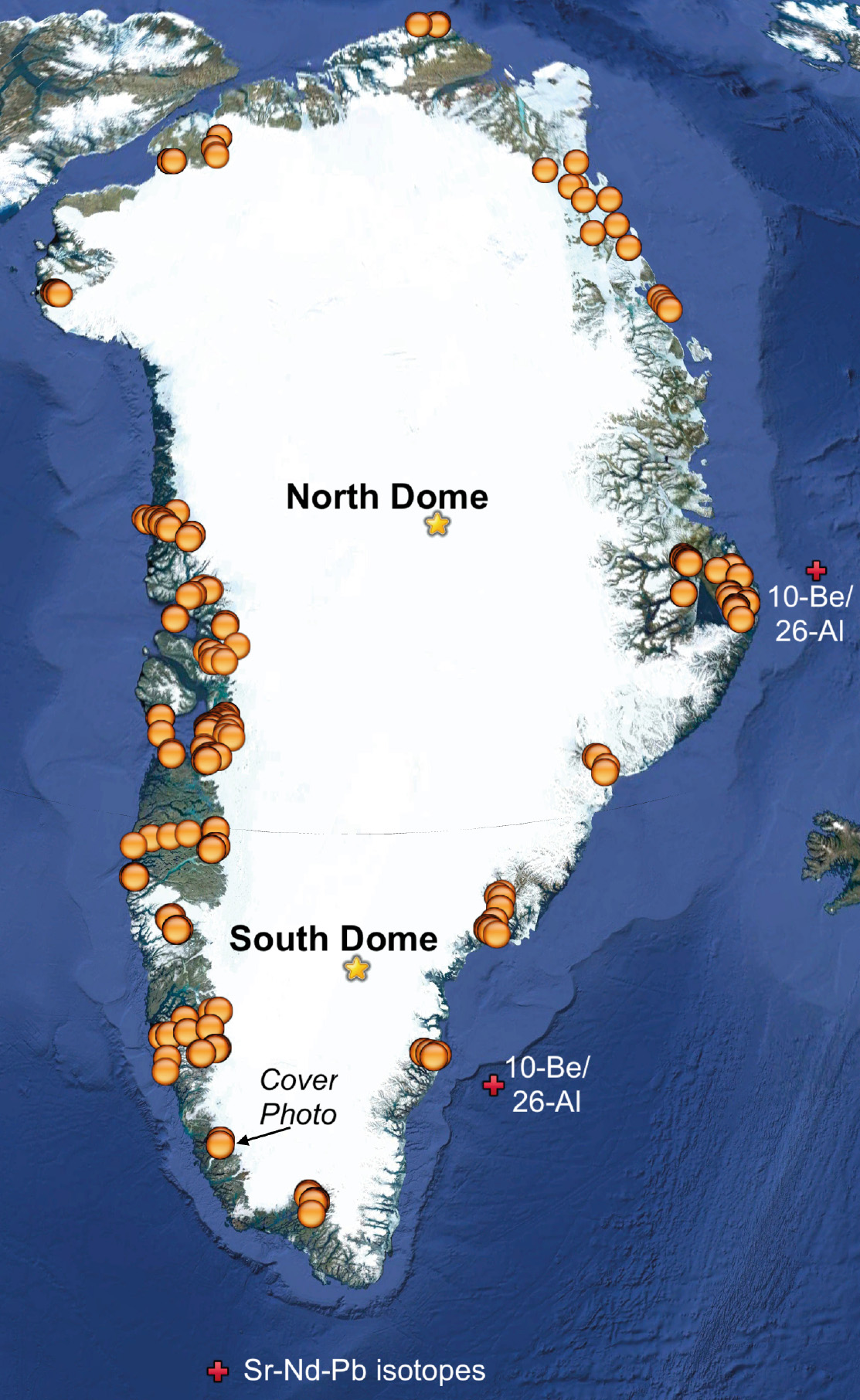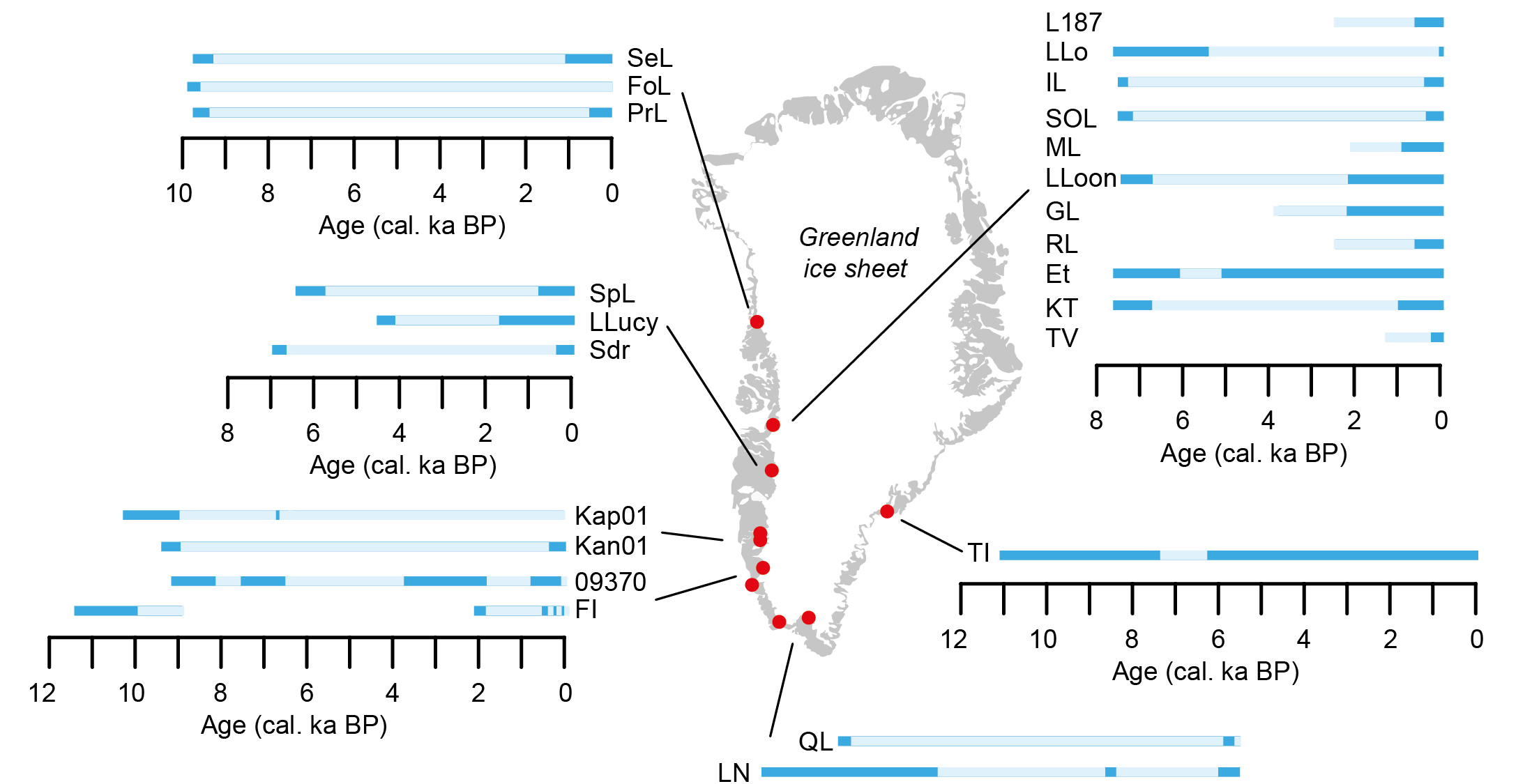- Home
- Publications
- PAGES Magazine
- Interglacial Ice Extents of The Greenland Ice Sheet
Interglacial ice extents of the Greenland ice sheet
Carlson AE & Larsen NK
Past Global Changes Magazine
27(1)
12-13
2019
Anders E. Carlson1 and Nicolaj K. Larsen2,3
The Greenland ice sheet has the capacity to raise sea level by ~7.4 m. Current terrestrial and marine data suggest that the ice sheet has usually been smaller than present during interglacial periods, showing a high sensitivity to current regional climate warming.
The Greenland ice sheet is the last surviving ice sheet of what was the order-of-magnitude larger extent of North Hemisphere ice sheets at the last glacial maximum about 21,000 years ago. As such, its responses to ongoing and future global warming represents a major concern regarding its impact on global sea level. In the last decade, the application of 10Be exposure dating along with “threshold” lakes dated by 14C now constrain the timing of when the Greenland ice sheet retreated to a smaller-than-present extent in the Holocene. Likewise, radiogenic isotopic tracers of silt-size particles combined with ice-rafted debris and subglacial bedrock cosmogenic isotopic concentration can provide evidence of how small the Greenland ice sheet may have been in prior interglacial periods. These data can provide important constraints on the sensitivity of the Greenland ice sheet to paleoclimates similar to, or warmer than, present.
The Holocene
The last deglaciation leading into the Holocene is characterized by abrupt climate changes recorded in Greenland ice cores. However, evidence for any response of Greenland ice-sheet margins on land is restricted mainly to the southernmost, westernmost and easternmost edges of Greenland; other terrestrial retreat of the Greenland ice sheet occurred during the Holocene (e.g. Young et al. 2013; Carlson et al. 2014; Larsen et al. 2015, 2018; Winsor et al. 2015; Young and Briner 2015; Sinclair et al. 2016; Reusche et al. 2018). This means that at an extended state on the continental shelf, the Greenland ice sheet appears to have been relatively stable and capable of surviving 10,000 years of deglacial warming before retreating to its current and then smaller-than-present extent.
The application of 10Be exposure dating in a number of fjord transects (Fig. 1) has demonstrated that the deglaciation from the coast to the present ice margin occurred in most places within ~500-1000 yr during the early Holocene (e.g. Winsor et al. 2015; Young and Briner 2015; Sinclair et al. 2016; Larsen et al. 2018). These yield retreat rates of 50-100 m yr-1, which are similar to, or higher than, retreat rates observed at even the most sensitive glaciers today (Winsor et al. 2015). In west and southwest Greenland, the ice-sheet retreat halted during the early Holocene in response to the ~9.3 kyr BP and 8.2 kyr BP cold events (e.g. Young et al. 2013; Winsor et al. 2015). Elsewhere in Greenland, evidence of early Holocene stillstands is lacking – not necessarily because they did not occur, but because late-Holocene advance may have overridden moraines from these stillstands (Carlson et al. 2014; Larsen et al. 2015, 2018; Sinclair et al. 2016; Reusche et al. 2018).
Cosmogenic ages on boulders next to modern ice margins (Fig. 1) and threshold lakes (Fig. 2), and radiocarbon dating on organic remains in historical moraines have been used to constrain periods with smaller-than-present ice extent (e.g. Carlson et al. 2014; Larsen et al. 2015; Young and Briner 2015). These records show that ice had retreated inland of its present extent during the Holocene thermal maximum ~8-5 kyr BP. This minimum ice extent was followed by a late-Holocene advance that culminated during the early 1900s with the formation of pronounced Little Ice Age moraines in most parts of Greenland (Kjeldsen et al. 2015). However, 10Be dating of moraines outside Little Ice Age moraines has shown that the ice extent was larger prior to the Little Ice Age in southernmost (Winsor et al. 2014) and northwestern Greenland (Reusche et al. 2018). These records indicate that for much of the last 10,000 years the Greenland ice sheet was at a more retracted extent than it was in the industrial era.
Prior interglacial periods
The last interglacial period, ~128-116 kyr BP, was an interval generally denoted as warmer than the peak Holocene due to greater precession forcing. Far-field sea-level indicators suggest that global mean sea level was 6-9 m above present, indicating that the global cryosphere was smaller than present. Marine sediment provenance records can constrain ice-sheet location on a given Greenland terrain (Colville et al. 2011). The dating of basal ice by the accumulation of radionuclide gases emitted from the underlying ground provides another means of reconstructing the Greenland ice sheet extent (Yau et al. 2016). The marine provenance records show that the southern Greenland ice dome survived through the last interglacial period (Fig. 1; Colville et al. 2011). The age of basal ice for the southern and northern Greenland domes is much older than the last interglacial (Fig. 1; Yau et al. 2016), in agreement with the marine records. These records suggest that the Greenland ice sheet only contributed less than 2.5 m (~35% of the modern ice-sheet volume; Colville et al. 2011) to the last interglacial sea-level highstand.
Prior to the last interglacial period, marine sediment provenance evidence indicates that the southern Greenland ice sheet nearly completely deglaciated during marine isotope stage 11 ~400 kyr BP (Reyes et al. 2014). This agrees well with the ~400 kyr BP age of basal ice and sediment from the south Greenland ice dome (Fig. 1; Yau et al. 2016). With a basal ice age of ~1000 kyr BP for the north Greenland ice dome (Fig. 1; Yau et al. 2016), these records suggest up to 6 m of sea-level rise coming from the Greenland ice sheet during marine isotope stage 11, accounting for the low end of global mean sea-level estimates for this interglacial period (Reyes et al. 2014).
On a longer timescale, marine and sub-ice cosmogenic records appear to be contradictory. For east Greenland, ice-rafted debris has been continuously deposited over the last three million years. The accumulation of 10Be and 26Al in this ice-rafted debris suggests the general persistence of the north Greenland ice dome in east Greenland over this time period with only short-lived periods of ice retreat and bedrock exposure (Fig. 1; Bierman et al. 2016). This would agree with the basal ice age of north Greenland ice dome of ~1000 kyr BP, suggesting a stable north Greenland ice dome over the latter part of the Quaternary (Yau et al. 2016). Conversely, the accumulation of 10Be and 26Al in the bedrock underlying the north Greenland ice dome could indicate multiple intervals of exposure during the Quaternary (Fig. 1; Schaefer et al. 2016), which would imply a more dynamic ice dome than can be inferred from the marine 10Be and 26Al records (Bierman et al. 2016) and basal ice ages (Yau et al. 2016). However, the eastern mountains of Greenland are one of the last places to deglaciate in Greenland ice-sheet models (e.g. Schaefer et al. 2016), suggesting that the two 10Be and 26Al records may not be in conflict. Nevertheless, it is difficult to rectify the ~1,000 kyr BP age of the north Greenland ice dome basal ice with the accumulation of 10Be and 26Al in the underlying bedrock. The application of a third, shorter-lived cosmogenic isotope from the bedrock, like 36Cl, could help in resolving the potential conflict between these two records.
Summary
The records discussed above demonstrate that the Greenland ice sheet has responded dramatically to past climate warming of only a few degrees Celsius or less above pre-industrial levels – warming levels we have already met or will meet in the next few decades. We can consequently conclude that we have reached, or will shortly reach, a climate state where the modern Greenland ice sheet is no longer stable (Carlson et al. 2014; Reyes et al. 2014).
affiliations
1College of Earth, Ocean, and Atmospheric Sciences, Oregon State University, Corvallis, USA
2Department of Geoscience, Aarhus University, Denmark
3Centre for GeoGenetics, Natural History Museum of Denmark, University of Copenhagen, Denmark
contact
Anders E. Carlson: acarlson coas.oregonstate.edu
coas.oregonstate.edu
references
Bierman P et al. (2016) Nature 540: 256-260
Carlson AC et al. (2014) Geophys Res Lett 41: 5514-5521
Colville EJ et al. (2011) Science 333: 620-623
Kjeldsen KK et al. (2015) Nature 528: 396-400
Larsen NK et al. (2015) Geology 43: 291-294
Larsen NK et al. (2018) Nature Commun 9: 1872
Reusche MM et al. (2018) Geophys Res Lett 45: 7028-7039
Reyes AV et al. (2014) Nature 510: 525-528
Schaefer JM et al. (2016) Nature 540: 252-255
Sinclair G et al. (2016) Quat Sci Rev 145: 243-258
Winsor K et al. (2014) Quat Sci Rev 98: 135-143
Winsor K et al. (2015) Earth Planet Sci Lett 426: 1-12
Yau AM et al. (2016) Earth Planet Sci Lett 451: 1-9


